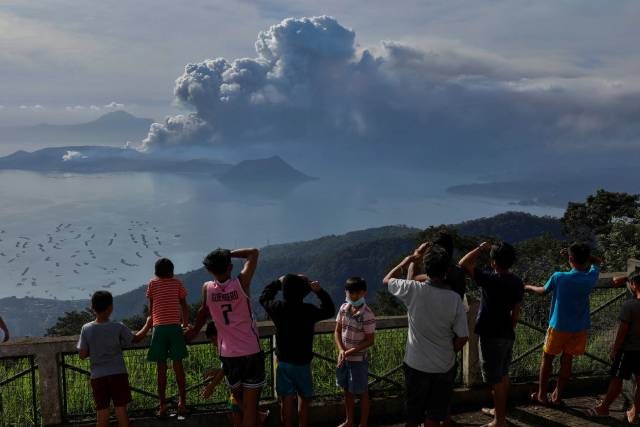
Filipinos, including a science organization, debunked false posts on social media following the steam-driven eruption of Taal Volcano yesterday afternoon.
Earth Shaker Philippines warned the public about the “explosion of fake news” on the internet and said that social media users should initially verify their sources before spreading such information.
“Please don’t forward unverified news and better re-check for other sources,” the organization said on its Twitter page.
Here are some of the false reports circulating online:
Mall of Asia’s foundation
Facebook posts and messages have circulated falsely warning the public to avoid going to SM Mall of Asia since its foundation has allegedly crumbled.
It does not directly reference Taal Volcano but it claimed that waters from Manila Bay were seeping to its foundation and only a “pumping system” was keeping the liquid away.
“‘Pag nasira ang mga pumps pwedeng mag-collapse ang MOA (Mall of Asia),” the text reads.

The fake message surfaced amid the ongoing eruption of the Taal Volcano since yesterday.
It has been debunked by the management of MOA in two separate statements.
“There is no truth to the information circulating on Social Media that the foundation of the Mall of Asia Complex has been compromised,” it said on Facebook.
“Moreover, Senior Management has not called for any meetings with Engineering on the said matter. The Mall of Asia Complex is on normal operations,” the statement continued.
The management in another statement emphasized that the mall’s foundation is built on concrete piles that “will withstand extreme situations.”
“The foundation of the SM Mall of Asia Complex is built on concrete piles that reach the bedrock and will withstand extreme situations. The statement where water will make the building collapse is patently false,” MOA said.
“We also have rigorous annual checks to ensure the safety of the buildings so at no time will the safety of our customers, tenants and employees be compromised,” it added.
Cosmic ray emission
A fake message being forwarded to text messages and social media also warned people that they should “turn off” their cellphones from 10:30 p.m. to 3:30 a.m. because of supposed high radiation from “cosmic rays.”
Although it wasn’t directly connected with the Taal Volcano eruption as well, the fake report emerged amid the unrest of the second most active volcano in the country.
It also dragged the names of television host and weather anchor Kim Atienza and BBC News, claiming that they supposedly reported the issue.
Atienza shared a screenshot of the message and warned his followers that it is a “recycled 10 year old fake news.”
“They spread it around whenever people are vulnerable at times of disaster. Totally untrue,” he wrote.
An ABS-CBN News report on 2014 debunked the claim and said that neither Atienza nor BBC News has reported that such a thing will happen.
It also noted that similar messages circulated in different countries like Ghana and the United States.
Snopes, a fact-checking website, rated the claim as “false” and said that events such as cosmic rays do not cause a direct health risk to humans.
“In terms of health effects to humans on the ground, this background cosmic radiation, similar to the solar radiation, poses no immediate harm and cannot be considered a health risk only unless you are chronically exposed to higher radiation levels in polar regions,” the website said, referencing National Oceanic and Atmospheric Administration.
Snopes added that such an event “would not be exacerbated by the presence of a cell phone near you.”
Earthquake predictions
Earth Shaker Philippines also warned people of fake articles claiming that 15 areas in Luzon would experience a “7.8 magnitude” of an earthquake on January 15, 2020, among others.
“We remind everyone that no reliable technology nor person can accurately predict earthquakes as of now. Please stop spreading such to avoid panic,” the organization said.
While there are no verified reports of an earthquake with such intensity, the Philippine Institute of Volcanology and Seismology has recorded several tremors near Taal Volcano, particularly in Cavite and Batangas.
The magnitudes mostly range from 2s to 3s, with the highest being 4.1 recorded twice early this morning, based on data collated by Philstar.com.
Phivolcs said that continuous low-intensity earthquakes in the Batangas province indicate Taal Volcano’s imminent explosion.
As of this writing, Alert Level 4 is raised over the volcano, which means that it is undergoing “intense unrest” and having seismic swarms including low frequency earthquakes. It also spewed lava fountains past two this morning.









